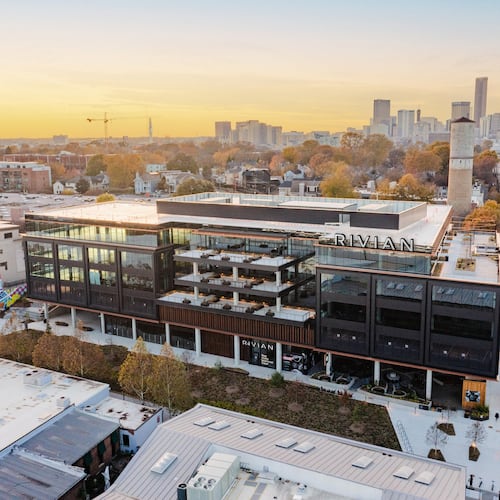The Dewar Wildlife Trust holds two tours a month, increasing to three a month during the summer. A group tour is $39 for adults, $19 for children. Individual tours start at $499. Information, 706-374-5109.
In the green woods of the North Georgia mountains, behind a computer-controlled electrified fence, an idiosyncratic millionaire keeps a menagerie of huge, powerful creatures.
It’s not exactly Jurassic Park. But it’s close.
Certainly the giants here are awe-inspiring. They include Kidogo, who, on a recent Tuesday, is reclining in the sunshine, chewing on a stick, his powerfully muscled 386-pound frame looking like the Incredible Hulk in a black fur coat.
Squatting next to Kidogo is Jasiri, who tickles his friend, then borrows the stick, which they share for a moment, both chewing quietly.
Though we know that these Western lowland gorillas could snap us in half like a twig, they appear, in this scene, as harmless and playful as puppies.
They are at ease, suggests their keeper Charles Horton, because they are living the life of Riley.
“It’s the Gorilla Hilton up here,” says Horton.
That is exactly as it was planned. Ten years ago software entrepreneur and British expatriate Steuart Dewar and his then-wife Jane Dewar opened Gorilla Haven as a retirement village for male gorillas on 300-plus acres of Fannin County forest, near Morganton, which is about two hours north of Atlanta. They built a 14-foot concrete wall that enclosed eight acres of green space, and high-tech “dorms” to house the gorillas at night.
With state of the art veterinary facilities and trained professionals overseeing the animals, the refuge earned approval from the Association of Zoos and Aquariums. The cost: about $6 million. Steuart Dewar, an old-school polymath who had made his fortune in newspaper publishing software, helped cover the cost of construction with the proceeds of a calendar application he tinkered together for Palm and Handspring devices.
Then the economy tanked, which hurt potential support from zoos, as well as Dewar’s revenues. One of their gorillas, Oliver, was transferred to the Columbus, Ohio, zoo in 2009, leaving them with a single resident, the aging and ailing Joe. And the Dewars went through a contentious divorce.
Hopes for the refuge dimmed. Steel panels for a planned expansion remained stacked in an unfinished group facility. Then Zoo Atlanta began to take an interest in the refuge as a possible solution for the ongoing challenge of the male gorilla.
Western lowland gorillas live in social units comprised of one adult male (a silverback), several females and their offspring. When young males grow up they are forced out of their clan by the dominant male, with the hope that they will start their their own social units. But since captive breeding programs have produced as many males as females (or even, during recent years, slightly more males than females, for no apparent reason), that means many males will not get lucky.
Zoos have tried to create bachelor groups so that adult males aren’t forced to live in solitary confinement. But for a facility such as Zoo Atlanta with a collection of 21 gorillas, assembling compatible groups in the smallish three acres available is as tricky as planning an anarchists convention.
When the teenaged Jasiri and Kidogo started beating up on the younger Mbeli in one of Zoo Atlanta’s bachelor groups, the newly-renamed Dewar Wildlife Trust offered a safety valve. The two older apes were moved to the trust from Atlanta in January of 2012. “It was great having this opportunity,” said Horton.
Zoo Atlanta pays for two full-time curators, Horton and Bobby Fellows, to care for the 14-year-old gorillas, both of which remain property of the zoo. The zoo also supplies other in-kind support, including gorilla chow.
Now the Dewar Wildlife Trust is opening the facility for tours, creating some revenue to offset operation expenses. (They play on the Jurassic look of the place by calling the enterprise “Dewarassic Tours.”) A youth group recently enjoyed an overnight at the facility, hanging their hammocks in one of the unused gorilla dormitories.
The gorillas enjoy the tours, said Dewar, as he and his wife, JoBeth Dewar, watch Fellows work on training with Kidogo (also called Willie B. Jr.). “They like being interactive.”
Zoo Atlanta’s deputy director Dwight Lawson says if his zoo acquired the refuge it could create a satellite facility that would appeal to a different geographical area, and could also provide elbow room allowing breeding programs for other animals, such as the Sumatran tigers. He points out that Atlanta’s zoo, at 36 acres, is smaller than most in a city of Atlanta’s size. (Riverbanks Zoo in Columbia, S.C., and the North Carolina Zoo in Asheboro, N.C. both exceed 100 acres.)
“It could be developed to appeal to an entirely different audience,” he said. The only challenge: cash.
What the zoo would get would be a superb facility, said Kristen Lukas, curator of conservation and science at Cleveland’s Metro Park Zoo, and chair of the Species Survival Plan for gorillas. Her group coordinates nationwide efforts to promote the health and genetic diversity of gorillas. The Dewars “really did a fantastic job in creating a facility that met the highest of industry standards,” she said.
For Kidogo and Jasiri, it’s just getting nicer. Workers are putting in a pond for the hot summer months. “It’s like the people who go up to Hiawassee for that spa treatment,” said Horton.
And the “boys,” as Dewar calls them, seem to enjoy each other’s company.
“This is a real success story,” said Horton, “Two totally adult males being about as bonded as I’ve ever seen males bonded.”
About the Author
Keep Reading
The Latest
Featured


